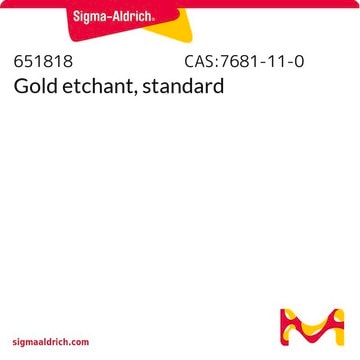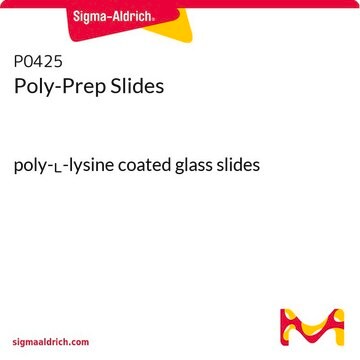643246
Gold coated glass slide
layer thickness 1000 Å, 99.999% (Au)
Sign Into View Organizational & Contract Pricing
All Photos(1)
About This Item
Linear Formula:
Au
CAS Number:
Molecular Weight:
196.97
EC Number:
MDL number:
UNSPSC Code:
12141717
PubChem Substance ID:
NACRES:
NA.23
Recommended Products
Assay
99.9% (Ti)
99.999% (Au)
L × W × thickness
3 in. × 1 in. × 0.7 mm
layer thickness
1000 Å
transmittance
380-700, >91% (for the glass microscope slide alone)
refractive index
n20/400 1.52 (lit.)
matrix attachment
Titanium, as adhesion layer used to bind the gold to the aluminosilicate glass cover slip
SMILES string
[Au]
InChI
1S/Au
InChI key
PCHJSUWPFVWCPO-UHFFFAOYSA-N
Looking for similar products? Visit Product Comparison Guide
Application
- Simple surface modification of poly(dimethylsiloxane) for DNA hybridization.: Highlights the application of gold-coated glass slides in creating effective biosensors for DNA hybridization, supporting innovations in genomics and pharmaceutical research (Zhou et al., 2010).
- Multimodal spectroscopy combining time-of-flight-secondary ion mass spectrometry, synchrotron-FT-IR, and synchrotron-UV microspectroscopies on the same tissue section.: Utilizes gold-coated glass slides to integrate multiple spectroscopic techniques, enhancing the analysis of complex biological samples, pivotal for cutting-edge research in biochemistry and material sciences (Petit et al., 2010).
Features and Benefits
The gold surface is polycrystalline but shows a tendency towards <111> orientation.
Other Notes
Titanium adhesion layer used to bind the gold to an aluminosilicate glass microscope slide
Storage Class Code
11 - Combustible Solids
WGK
nwg
Flash Point(F)
Not applicable
Flash Point(C)
Not applicable
Choose from one of the most recent versions:
Already Own This Product?
Find documentation for the products that you have recently purchased in the Document Library.
Customers Also Viewed
Fengxian Zheng et al.
Journal of nanoscience and nanotechnology, 13(6), 3990-3998 (2013-07-19)
Gold nanoparticles (AuNPs) are of biomedical importance, such as delivery vectors. Therefore, we used all-atom molecular dynamic simulations to study the interaction of AuNPs with cell membrane (DMPC bilayer). We observed that the AuNPs adhered spontaneously on the surface of
Claudia Diletto et al.
Journal of nanoscience and nanotechnology, 13(7), 5215-5220 (2013-08-02)
Innovative hybrid nanocomposites based on a nanostructured block copolymer (BCP) matrix whose lamellar nanodomains are selectively loaded with metal nanoparticles, have been prepared. A symmetric poly(styrene-b-methylmethacrylate) (PS-b-PMMA) amorphous BCP showing a lamellar morphology has been employed. Thin films of PS-b-PMMA
Bibek Jyoti Borah et al.
Journal of nanoscience and nanotechnology, 13(7), 5080-5087 (2013-08-02)
Multifunctional phosphine based ligands, 1,1,1-tris(diphenylphosphinomethyl)ethane [CH3C(CH2 PPh2)3][P3] and 1,1,1-tris(diphenylphosphinomethyl)ethane trisulphide [CH3C(CH2P(S)Ph2)3][P3S3] have been introduced to stabilize Au(o)-nanoparticles having small core diameter and narrow size distribution. The Au(o)-nanoparticles were synthesized by the reduction of HAuCl4 precursor with NaBH4 in the presence
Young Min Bae et al.
Journal of biomedical nanotechnology, 9(6), 1060-1064 (2013-07-19)
We report on the enhancement of sensitivity of SPR biosensor by modifying the metal surface. A mixture layer, in which gold and dielectric medium coexist, was simply prepared by increasing the roughness of gold surface deposited onto a glass substrate
Yoon-Chae Nah
Journal of nanoscience and nanotechnology, 13(5), 3470-3473 (2013-07-19)
Au nanoparticles and poly(3-hexylthiophene) (P3HT) composite films were prepared by electrodeposition of Au nanoparticles using pulse-current electrodeposition followed by the spin coating of P3HT and their enhanced electrochromic coloration was investigated. A relatively uniformed Au nanoparticle was obtained by the
Our team of scientists has experience in all areas of research including Life Science, Material Science, Chemical Synthesis, Chromatography, Analytical and many others.
Contact Technical Service







